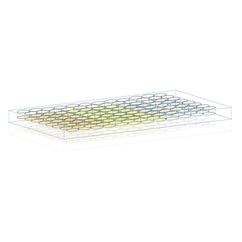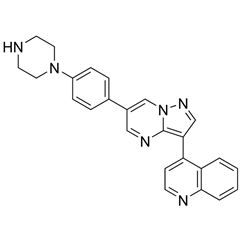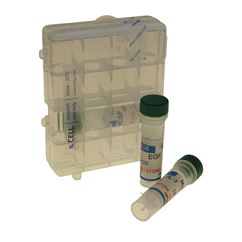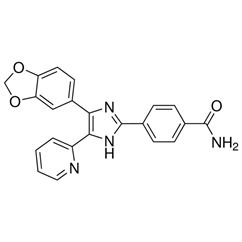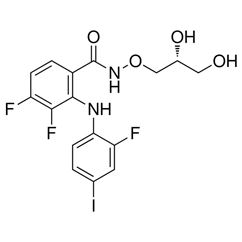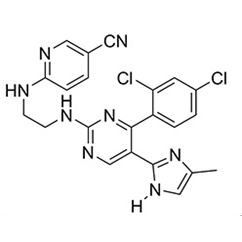PODS® Human TNF-α
PODS® Technology
PODS® proteins are made using an insect cell expression system in which the active protein is co-expressed alongside polyhedrin carrier protein. Polyhedrin forms microcrystals within insect cells which specifically capture the active protein to form a co-crystal complex. The active protein is captured in its nascent, natively folded form with limited scope for proteolytic degradation. Consequently, excellent levels of bioactivity are observed. The PODS® co-crystals provide a sustained release mechanism and can be used to functionalize surfaces. For further details, please refer to the PODS® Technology page.
Product Description
The product contains the polyhedrin protein co-crystalized with Human TNF-α. Tumor Necrosis Factor alpha (TNF-α) is a prototypic ligand of the TNF superfamily, a pleiotropic pro-inflammatory cytokine secreted by various cells, including adipocytes, monocytes, macrophages, B cells, T cells, fibroblasts, and tumor cells. Thus, playing an important role in inflammation, immune system development, apoptosis, and lipid metabolism. There is significant cross-species reactivity between human and mouse cytokines.
Usage Recommendation
PODS® co-crystals provide a depot of proteins which are steadily secreted. It has been estimated that the biological activity of 50 million PODS® co-crystals generates the same peak dose as 3.3 µg of standard recombinant protein. However, at 5 days following the start of seeding the PODS® co-crystals, there are more than 50% of these peak levels still present in the culture system. Ultimately, the amount of PODS® co-crystals that is optimal for a particular experiment should be determined empirically. Based on previous data, we suggest using 50 million PODS® co-crystals in place of 3.3 µg of standard growth factor as a starting point.
To control for cross-reactivity with cells or as a negative control, we recommend using PODS® growth factors alongside PODS® Empty crystals, as the latter do not contain or release cargo protein.
Animal-Free
This product is produced with no animal derived raw products. All processing and handling employs animal free equipment and animal free protocols.
AA Sequence
Immobilization tag shown in blue.
MADVAGTSNR DFRGREQRLF NSEQYNYNNS KNSRPSTSLY KKAGFVRSSS RTPSDKPVAH VVANPQAEGQ LQWLNRRANA LLANGVELRD NQLVVPSEGL YLIYSQVLFK GQGCPSTHVL LTHTISRIAV SYQTKVNLLS AIKSPCQRET PEGAEAKPWY EPIYLGGVFQ LEKGDRLSAE INRPDYLDFA ESGQVYFGII AL
Alternative Names
TNFalpha, tnfa, tnf-a, TNF-alpha, TNF-alphacachectin, TNFATNF macrophage-derivedAPC1 protein, cachectin, Cachetin, DIF, TNFSF1A, TNFSF2, TNFSF2TNF superfamily member 2, tumor necrosis factor member 2, tumor necrosis factor alpha, tumor necrosis factor li
Research Use Only
This product is for Research Use Only.
| Product Details | |
|---|---|
| Length | 222 aa |
| Molecular Weight | 22.5 kDa |
| Structure | Monomer |
| Source | Spodoptera frugiperda (Sf9) cell culture |
| Accession Number | P01375 |
| Endotoxin Level | <0.06 EU/ml as measured by gel clot LAL assay |
| Formulation | PODS® were lyophilized from a volatile solution |
| Reconstitution |
PODS® co-crystals may be reconstituted at 200 million co-crystals/ml in sterile PBS. 20% glucose has a buoyant density closer to PODS® co-crystals and can be useful for aliquoting. PODS® co-crystals are highly stable when stored in aqueous solution (pH range 6 - 8). |
| Stability and Storage | Upon receipt, store at 4°C. PODS® co-crystals are stable for at least 1 year when dry and 6 months when resuspended. |
References
Hiroshi Ijiri, Fasséli Coulibaly, Gento Nishimura, Daisuke Nakai, Elaine Chiu, Chiemi Takenaka, Keiko Ikeda, Hiroshi Nakazawa, Norio Hamada, Eiji Kotani, Peter Metcalf. Structure-based targeting of bioactive proteins into cypovirus polyhedra and application to immobilized cytokines for mammalian cell culture. (2009) Biomaterials. 30(26): 4297-4308.
Shimabukuro J, Yamaoka A, Murata K, Kotani E, Hirano T, Nakajima Y, Matsumoto G, Mori H. 3D co-cultures of keratinocytes and melanocytes and cytoprotective effects on keratinocytes against reactive oxygen species by insect virus-derived protein microcrystals. (2014) Materials and Science Engineering. 42: 64-69.
Fasséli Coulibaly, Elaine Chiu, Keiko Ikeda, Sascha Gutmann, Peter W. Haebel, Clemens Schulze-Briese, Hajime Mori, and Peter Metcalf. The molecular organization of cypovirus polyhedra. (2007) Nature. 446: 97-101.
Rey FA. Virology: Holed up in a natural crystal. (2007) Nature. 446: 35-37.
Mori H. Immobilization of Bioactive Growth Factors into Cubic Proteinous Microcrystals (Cypovirus Polyhedra) and Control of Cell Proliferation and Differentiation. (2010) NSTI-Nanotech. 3: 222-225.
Satoshi Abe, Hiroshi Ijiri, Hashiru Negishi, Hiroyuki Yamanaka, Katsuhito Sasaki, Kunio Hirata, Hajime Mori, and Takafumi Ueno. Design of Enzyme-Encapsulated Protein Containers by In-Vivo Crystal Engineering. (2015) Advanced Materials. 27(48): 7951-7956.

